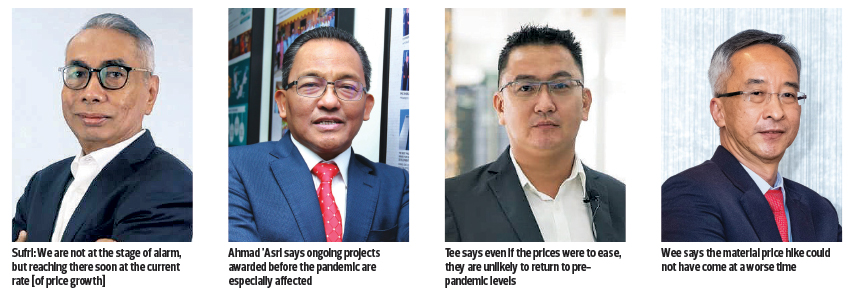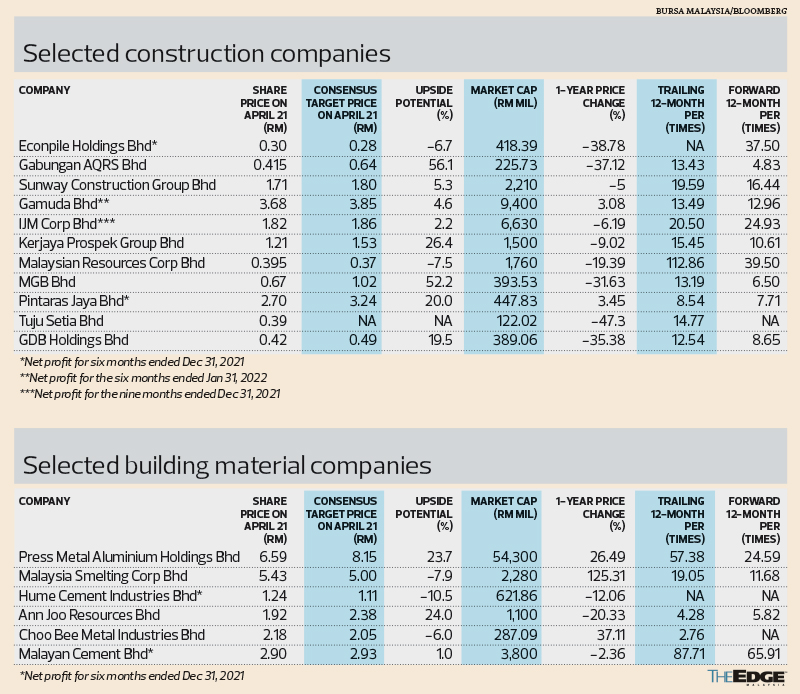
This article first appeared in The Edge Malaysia Weekly on April 25, 2022 - May 1, 2022
AS economic activity continues to pick up pace amid the country’s transition into endemicity, supply chain disruptions and soaring building material costs brought about by Russia’s invasion of Ukraine, and labour shortages threaten to derail the construction sector’s recovery, say analysts.
After losing more than RM42 billion because of lockdowns in the past two years, construction companies are looking forward to seeing more mega projects being launched, with the RM31 billion Mass Rapid Transit Line 3 (MRT3) project — whose tenders will be called next month — set to start the ball rolling.
The Master Builders Association Malaysia recently warned, however, that rising building material costs are hampering the industry’s growth and could force many contractors to go out of business. As such, MBAM is calling for government intervention to cool down prices.
Moving in tandem with global prices, overall average local material costs have risen 10% to 40% since the start of the year.
“We are not at the stage of alarm, but reaching there soon at the current rate [of price growth]. The fear of prices shooting up further or a sudden dip or dump has created an uncertain situation, whereas [property] developers have doubts on launching new projects,” MBAM president Tan Sri Sufri Mhd Zin tells The Edge.
The impact of the rise in costs of materials on infrastructure projects is huge, as steel bar, cement and diesel costs account for at least 30% of the whole contract sum, he says.
“For building projects, key materials such as steel bar, cement and diesel account for a lower percentage —10% to 15%. However, the prices of diesel affect logistics costs for other materials such as tiles, bricks, roofing and aluminium, which collectively comes to 30% to 40% of the total contract sum,” he adds.
Prices of steel bars are reported to have risen 30.6% to RM3,500 per tonne, from RM2,680 per tonne in February 2021, while those of bulk cement have increased 66.7% to RM350 per bulk, from RM210 per bulk. Diesel prices have risen 128.4% to RM4.34 per litre, from RM1.90 per litre in February 2021.
Sufri says because most construction contracts range from 18 to 48 months, material costs have already increased about 70% for those projects secured in early 2020, thus affecting contractors’ profit margins.
“Many contractors are struggling very badly and some have already closed down. For awarded contracts, contractors cannot pass on the additional costs at all. For certain government or public contracts, however, there is a variation-of-price (VOP) clause that allows contractors to claim the price fluctuations; thus, they are not as badly affected as those [with] private contracts,” he explains.
Still, amid a volatile market, prices of materials are dynamic and affected by factors such as logistics, payment terms, stock availability and raw material prices. As these factors are constantly changing, the VOP rate is unable to capture these changes on time to make adjustments.
“At present, the numbers provided by the Department of Statistics Malaysia do not fully reflect the current actual prices. There are differences of between 40% and 60%, depending on the materials,” Sufri says.
Construction Industry Development Board (CIDB) CEO Datuk Ahmad ’Asri Abdul Hamid concurs, noting that ongoing projects that were awarded before the pandemic are especially affected, as the projects are priced lower, with no allowance for price increases, owing to the hike in building material prices.
“This resulted in the contractors having their profits reduced or, in some cases, suffering losses. Despite this, the contractors still have to continue executing the projects until completion,” he says in an email response to questions from The Edge.
“As for new contracts, contractors can manage by pricing in the current material prices and quoting prices, with sufficient margins, to cover unexpected costs, including unforeseen increases in material prices.”
While contractors from both the public and private sectors are affected by the increase in material prices, the VOP clause was reintroduced for government contracts on July 15, 2021, to mitigate the impact of material price increases.
“Following the implementation of the VOP for government projects, the private sector is encouraged to take a similar approach in implementing projects, for a win-win situation between project owners and contractors and to ensure project completion,” says Ahmad ’Asri.
Kerjaya Prospek Group Bhd CEO and executive director Tee Eng Tiong says higher building material prices are likely to affect the profit margin of the group’s projects bagged earlier, as it is unable to fully pass on the additional costs to developers.
“Contractors in general will be able to pass on the additional costs only partially. Within the industry, contractors have been talking to developers and other related parties to mitigate the impact brought on mainly by higher material prices,” he tells The Edge.
On Kerjaya Prospek’s part, Tee says it has adjusted its strategy to price the increased costs into its tender offers to optimise its profit margins. “We also implement an industrialised building system to reduce wastage of building materials as well as leverage our strong cash position to obtain raw materials at more favourable prices to reduce the impact of rising building material prices on our operations.”
High material prices are here to stay
Tee expects prices of building materials to remain volatile in the short term. Even if the prices were to ease, he says, they are unlikely to return to pre-Covid-19 pandemic levels.
“China’s current strict lockdowns will have an indirect impact on global trades and economic growth. Also, most countries are expected to raise their respective interest rates — some by 50 basis points. This undoubtedly will lead to reduced spending. Taking all these into consideration, I believe [Malaysian] contractors’ financial performance this year will be affected,” he says.
“Already, some of the smaller contractors have been badly affected by the impacts of the pandemic such as the increase in building material prices, construction sites’ operation disruptions due to the various [Covid-19] movement restrictions and the shortage of foreign labour. These challenges have resulted in numerous contractors closing down and delays in certain projects.”
Tee adds that Kerjaya Prospek is fortunate that its prudent approach so far has allowed it to minimise the impact of high building material costs.
Still, not every contractor is able to overcome the rise in building material costs.
An executive from a small-cap construction firm who declined to be named says: “Unfortunately, we are unable to pass on the additional cost. Usually, for projects in the private sector, we don’t have any provision for variation orders, unlike projects in the public sector.
“Some clients may compensate us on a goodwill basis, but it’s very rare. We intend to mitigate this problem by undertaking necessary prudent measures to ensure the stability of our finances and business operations.”
He adds that the company does not store inventories on a long-term basis but orders them according to the progress of the project.
“One of the reasons is that steel bars will rust over time; so, it’s not advisable to keep them for too long, as additional costs will be incurred to clean the rust. Another reason is the additional storage charges that we would incur if we chose to store inventories.”
The executive adds that the commodity price movement is cyclical. “Raw material prices are always fluctuating and we have to take that into account in our tender pricing. It will definitely eat into our profit margins, but it is still [too] early to say whether it will be significant, given that we are also managing the rising costs in a prudent manner.
“But, yes, if costs are not managed carefully, it is possible to result in the closing down of business for some contractors.”
Tuju Setia Bhd managing director Wee Eng Kong says, like its peers that provide services for the private sector, the company’s contracts do not include clauses to pass down additional costs after securing past projects. Having said that, current tenders reflect price trends towards normal margins.
“The drastic increase in building material prices, along with the rise in subcontractor and foreign labour costs, is unprecedented. This is not only affecting the profitability of our projects secured last year, but similar challenges are also being faced by [our] peers in the construction sector,” Wee tells The Edge.
He notes that the material price hike could not have come at a worse time, as construction players are still trying to recover from the lockdowns over the past two years and are now being hit by an acute increase in material prices.
“If the prices of metals and other commodities remain at their current level or trend higher for the rest of the year, we would have to shoulder the additional costs, and that would affect the financial performance,” Wee says, adding that the company has been approached by parties to provide aid in regard to rescuing and/or taking over projects and companies.
“Everyone needs to manage their own affairs as prudently as they can.”
He says Tuju Setia does not hold large quantities of building materials in its inventory, as this will tie up its working capital and cause the quality of some materials to deteriorate over time. “Instead, our purchases are arranged in stages according to the progress of our projects. Therefore, we do not have the freedom to avoid unfavourable price points during challenging market conditions.”
CIDB’s Ahmad ’Asri points out that the price of steel reinforcement bars has surged the most since 2020, up 56% between October 2020 and March 2022. “Lately, cement prices have shown a rising trend. As such, projects that use the most of this material will be badly affected.”
Monthly building material price collection conducted by CIDB shows that cement prices have risen 30% since January last year; bitumen Grade 60/70, 30%; river sand, 17%; ready-mixed concrete, 24%; and aggregate prices, 14%.
Ahmad ’Asri says: “The increase in material prices will [raise] construction costs by 8% to 15%. There is a possibility that projects will be delayed or abandoned if contractors cannot absorb the additional cost incurred. This will indeed jeopardise the recovery of the construction sector if the current situation is prolonged.”
Save by subscribing to us for your print and/or digital copy.
P/S: The Edge is also available on Apple's App Store and Android's Google Play.


